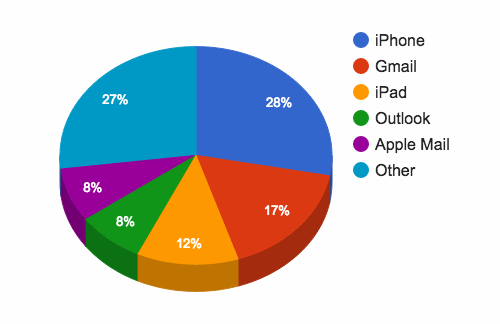Blog posts tagged email marketing
How to master responsive email design
When you were growing up, did you ever have breakfast cereals with a toy inside? Not knowing what you'd find nestled within your cornflakes gave you a good reason to get on and eat the entire box in a single sitting.
The element of surprise was exciting back then. But it doesn't translate quite so well to the world of email marketing.
Do your emails look their best?
When you send out marketing emails, they'll be opened by people using an array of email clients. Can you be sure that your emails will look good in Outlook, in Google Mail, on an iPhone and on a tablet computer?
This isn't something you want to leave to chance. Every email client has its own quirks, so this blog post takes a look at how to make sure your emails look good in as many of them as possible.
Although there are a lot of email clients out there, the top five make up around 73% of the market. If you cater for these, you'll be well on your way to running successful email campaigns:
Why does responsive email matter?
You can see from the chart above that people tend to open emails on mobile devices more than anything else.
To ensure your emails look right on mobile devices, you need to make your emails responsive.
You might have heard of responsive web design before. With emails, it's the same: a responsive email changes shape and size so that it displays properly on the screen of any device.
Essentially, it adapts itself to fit anything from big desktop monitors to tiny smart phone screens.
The HTML code from which responsive emails are built can be complicated. The basics are straightforward, but the code required to cater for different devices can become confusing.
For this reason, we don't recommend attempting to code HTML emails yourself, unless you're confident and experienced at working with HTML.
However, taking some time to understand the principles underpinning email design will make it easier to work with designers and developers.
What to ask your email developer
Here are some things to ask a developer who's working on your marketing emails:
- Have we checked what devices our recipients use?
The graph shown above is taken from Litmus. It's a good overall view of email client use, but your own customers might have a different profile. For instance, if your email subscribers tend to be people in large companies, you might find more of them use Microsoft Outlook. Your existing email marketing tool may be able to show what clients and devices your recipients use. - How flexible is the width of the email?
Catering for different screen widths is fundamental to successful responsive email design. Designing your emails with a few key screen sizes in mind is key. Ask your developer to show you how the email changes as it appears on screens of different sizes. - Have you put the key styles in line?
Bear with us — we're going to get a little technical. The appearance of visual elements is governed by cascading style sheets (CSS). These define, for instance, what font, size and colour should be used to display text. When building a website, the CSS is usually separated from a page's HTML code. But when creating an email, your developer should include the CSS with each individual element. This is called 'in line CSS'. - What proportion of clients have we tested it with?
It's very hard to create an email that looks perfect on 100% of email clients and devices. (You can do it, but it would cost a fortune.) There are just too many permutations to cater for. The best way to spend your budget is to concentrate on the email clients your recipients are using. Cover 80% of these and you're doing well.
Remember: when you're building marketing emails, you can avoid duplicating your efforts by creating a few email templates to edit and reuse easily for regular campaigns.
And finally, once you create those templates, test them on different platforms and devices. Make sure your customers see what you want them to see.
Copyright © 2015 Amir Jirbandey, expert contributor to the Marketing Donut.
How to handle your post-holiday inbox
 We’re all familiar with that day of reckoning. It’s usually a Monday. You’ve probably been stuck in a traffic jam or on a full train on the way to work. And once you arrive, you have a two-week email backlog to get through.
We’re all familiar with that day of reckoning. It’s usually a Monday. You’ve probably been stuck in a traffic jam or on a full train on the way to work. And once you arrive, you have a two-week email backlog to get through.
Your post-holiday email can be demoralising, even if you did the right things to prepare before you went away. So, here’s a five-step action plan to help you deal your inbox while staying relaxed and in control.
1. Talk to people
Before you open your email, talk to your colleagues. If someone else was handling your workload in your absence, sit down over coffee and get them to sum up what’s happened.
That way, when you do delve into your inbox, you’ll have a better idea of what needs attention.
2. Sort by sender
You know who your most important contacts are, so sorting messages by the sender’s name is a good way to identify key messages.
But don’t rush to reply to messages immediately. First of all, move onto step three…
3. See the big picture
Skim through your inbox and identified the main priorities. Then handle the most important messages first. Use the ‘4Ds’ principle to take care of the highest-priority messages.
Either deal with an email immediately, delegate to someone else, delete the message or defer it. As you reply, make sure you’ve checked the whole email chain. Has anyone already answered on your behalf?
4. Address less important messages
Once you’ve applied the 4Ds principle to your most important emails, go back through your inbox and deal with second priority emails in the same way.
Many of these will probably be circulars that can be left for a while, or maybe even deleted. Be ruthless before replying and ask what your reply will contribute at this stage. Don’t waste your time — or that of your recipients.
5. After a week, delete everything else
Yes, it sounds drastic, but once you’ve been back at work for a week then any emails you haven’t yet dealt with will be well past their sell-by dates.
If — by some faint chance — you have missed something, you can be sure the sender will contact you again.
- Email overload is damaging productivity
- When it comes to email replies, is faster always better?
- How to sort out your email once and for all
Copyright © 2014 Monica Seeley. Monica is the founder of Mesmo and a leading expert on email best practice.
How the cookie law affects email marketing
 The much-maligned new EU cookie law isn’t just about cookies. Actually, the text of the regulation doesn’t even mention cookies by name. Instead, its focus is on making people more aware of how their information is used online, and helping people control their privacy.
The much-maligned new EU cookie law isn’t just about cookies. Actually, the text of the regulation doesn’t even mention cookies by name. Instead, its focus is on making people more aware of how their information is used online, and helping people control their privacy.
Essentially it means people now have to actively opt-in before their information is used or their behaviour is tracked in many ways.
The new regulation also applies to other technologies that involve you placing and accessing information on someone’s computer. For instance, the new rules apply to the tiny ‘web beacons’ (actually small image files) used to track when a marketing email is opened.
Some criticism has been levelled at the Information Commissioner’s Office (ICO) for not issuing clear guidance. But actually, to understand what’s expected of companies, we need to step back from the nuts and bolts and look at what the law is trying to achieve.
One that front, the ICO’s message has been consistent: businesses need to be open and transparent, because the law is intended to protect privacy and promote openness.
The new law and email marketing
Plenty has already been said about how the new law affects website cookies. (Read the IT Donut guide, if you need help). So I’m going to look at what happens if your business sends marketing messages by email.
If your company falls into that category, you probably track how people interact with your messages. Crucially, you probably have a tool that lets you see how many people open the emails you send.
Just as with cookies, you need to ask a key question about this ‘open tracking’: what’s its purpose? Just as all cookies aren’t equal, neither is all open tracking.
If you’re using open tracking to report an overall open rate for your entire email campaign, I don’t see how this can come under the new law. It’s just a broad way of tracking how people are interacting with your emails.
Would your email subscribers be surprised to know that you work to get emails delivered and monitor success by checking if the emails are read? I think not. And that’s why I think tracking mechanisms used in this way would fall outside the law.
The law applies when the data gets personal
But here’s a different theoretical case. Say a travel company spots that someone opens emails related to family holidays, then sells that information to a company which then targets them with adverts for child investment products.
This sort of open tracking would certainly fall within the regulations as it clearly involves the privacy of the individual. (I’m just using this example to make the point clear - I don’t actually think anyone does anything even close to this with open tracking!)
Getting new subscribers to opt-in
Having said that, the new law is about openness and transparency. So to be safe, it’s a good idea to keep your email subscribers informed about the tracking you use.
It should be relatively easy to ask new subscribers to opt-in to tracking and cookies. You have to get permission to send them emails anyway, so when you do so just add information about the tracking too.
Remember: openness and transparency are key. So don’t bury the information deep in a policy privacy policy or write it using confusing language. Make it clear and obvious, and reinforce it in your welcome email. For example:
We work hard to avoid cluttering up your inbox by using technology to understand what we should send you. Read how here.
Then, no matter whether you think open tracking is or isn’t covered by the regulations, you’ll know you’re covered. And your customers will be better informed too.
Making sure current subscribers know the score
With new subscribers taken care of, think about what to do your current subscriber base. You need to ask two questions: how do you use open tracking and what would your subscribers reasonably expect you to be doing?
Again, it’s about openness and transparency. You can make current subscribers aware of your use of tracking. Add information about it to your email header. Use the same language you use for new subscribers and keep the information there until it’s reasonable to assume everyone’s seen it. Then you can move it to your email footer.
Don’t panic about your open tracking
In any case, if you have worked to promote openness and transparency you will be in a much better position with the ICO than if you have simply ignored this issue. In short:
- Tell new email subscribers what tracking technology you used. Explain it in simple, clear language that can be easily understood.
- Make sure you include this information if you have a soft opt-in – like when you sign people up as part of a purchasing process on your website.
- Change your privacy policy so people who opt in to emails are also opting in to your open tracking and cookie-based tracking.
- Provide a clear link to your full privacy policy as part of the sign up process, and add a summary to any welcome emails you send out.
- Tell your current subscribers about tracking through an email header. You can move this to the footer once it’s reasonable to think most people will have seen it.
Finally, don’t panic. While the ICO can impose fines of up to £500k, they’re only likely to do so in exceptional circumstances. It needs to be a serious, deliberate contravention of the law that causes substantial damage or distress. Quite simply, I find it hard to envisage a situation where email open tracking could do that.
- Download our guide to the EU cookie law (PDF link)
- Changing how the cookie crumbles – are you compliant?
- Read Rory MccGwire's blog in the Law Society Gazette
Tim Watson is an independent email marketing consultant who writes for Smart Insights.



